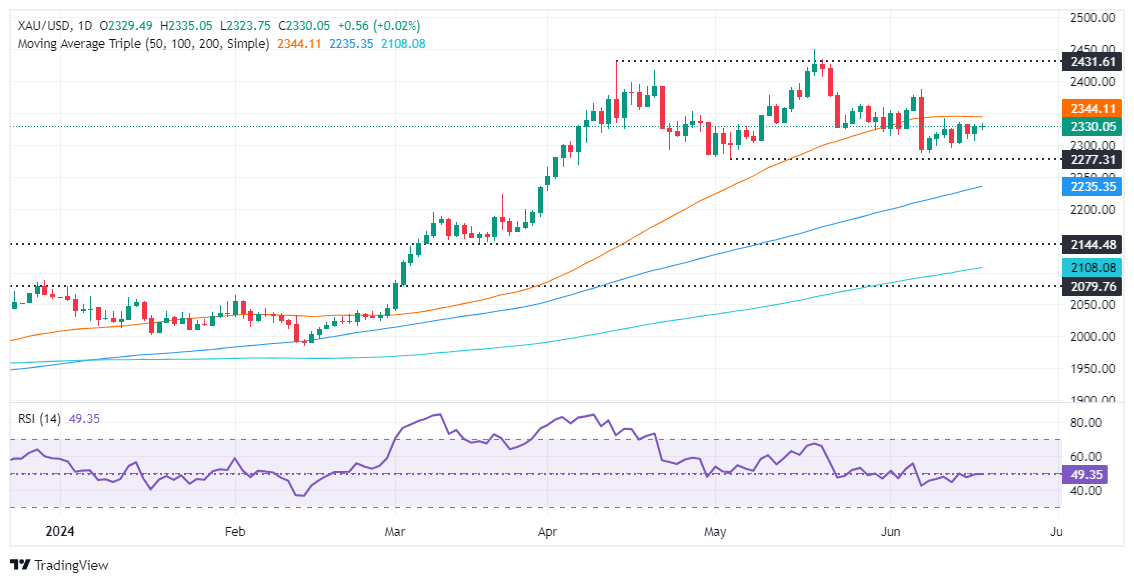Gold price climbs as US data fuels rate cut hopes amid cautious Fed rhetoric
- Gold remains virtually unchanged during the North American session due to thin volume.
- US Retail Sales and Industrial Production data hint at an economic slowdown, boosting rate cut expectations.
- FedWatch Tool shows 67% chance of September rate cut with December 2024 futures implying 36 bps of easing.
Gold's price barely moved Wednesday during the North American session as traders remained absent in observance of the Juneteenth holiday. Data from the United States (US) continued to weaken, a sign of relief for traders who remain confident the Federal Reserve (Fed) will ease policy twice this year. Therefore, precious metals recover some ground, yet XAU/USD is virtually unchanged and trades at $2,328 at the time of writing.
US Retail Sales in May improved compared to April, but they were revised downward, hinting that the economy is slowing down. This data, along with last week’s big consumer inflation report, increased the odds of a September rate cut.
Other data showed that Industrial Production improved in May, followed by a downward revision in April.
The CME FedWatch Tool shows that odds for a 25 basis points (bps) rate cut for September, stands at 67%, up from 61% a day ago. In the meantime, the December 2024 Fed funds futures contract implies the Fed will cut 36 bps toward the end of the year.
In the meantime, Fed speakers entertained Gold traders on Tuesday, saying that inflation remains high and that they need more evidence that inflation is evolving to reach the 2% core inflation goal.
US Treasury bond yields remained subdued. Still, the 10-year Treasury note yield is down one-and-a-half basis points to 4.215%.
Daily digest market movers: Gold price consolidates amid thin liquidity conditions
- US Dollar Index (DXY) is flat at 105.25, a tailwind for Gold prices.
- May’s US Retail Sales improved but failed to underpin the Greenback. However, that and a solid Industrial Production report capped the non-yielding metal’s advance.
- Fed officials counseled patience on interest rate cuts and emphasized they would remain data dependent. Although last week's CPI report was positive, policymakers reiterated they need to see more reports like May’s data.
- Despite the US CPI report showing that the disinflation process continues, Fed Chair Jerome Powell commented that they remain “less confident” about the progress on inflation.
Technical analysis: Gold price remains bearishly biased despite consolidating at around $2,330
The Head-and-Shoulders pattern remains in place, hinting that Gold prices might drop toward the $2,200 figure and below. Momentum suggests that neither buyers nor sellers are in charge as the Relative Strength Index (RSI) meanders around the 50-neutral line.
Due to the presence of a Head-and-Shoulders chart pattern, XAU/USD could be headed to the downside in the near term. That said, if XAU/USD slides past $2,300, the next support would be the May 3 low of $2,277, followed by the March 21 high of $2,222. Further losses lie underneath, with sellers eyeing the Head-and-Shoulders chart pattern objective from $2,170 to $2,160.
On the flipside, if Gold extends its gains past $2,350, key resistance levels emerge like the June 7 cycle high of $2,387, ahead of challenging the $2,400 figure.

Economic Indicator
Fed Interest Rate Decision
The Federal Reserve (Fed) deliberates on monetary policy and makes a decision on interest rates at eight pre-scheduled meetings per year. It has two mandates: to keep inflation at 2%, and to maintain full employment. Its main tool for achieving this is by setting interest rates – both at which it lends to banks and banks lend to each other. If it decides to hike rates, the US Dollar (USD) tends to strengthen as it attracts more foreign capital inflows. If it cuts rates, it tends to weaken the USD as capital drains out to countries offering higher returns. If rates are left unchanged, attention turns to the tone of the Federal Open Market Committee (FOMC) statement, and whether it is hawkish (expectant of higher future interest rates), or dovish (expectant of lower future rates).
Read more.Last release: Wed Jun 12, 2024 18:00
Frequency: Irregular
Actual: 5.5%
Consensus: 5.5%
Previous: 5.5%
Source: Federal Reserve